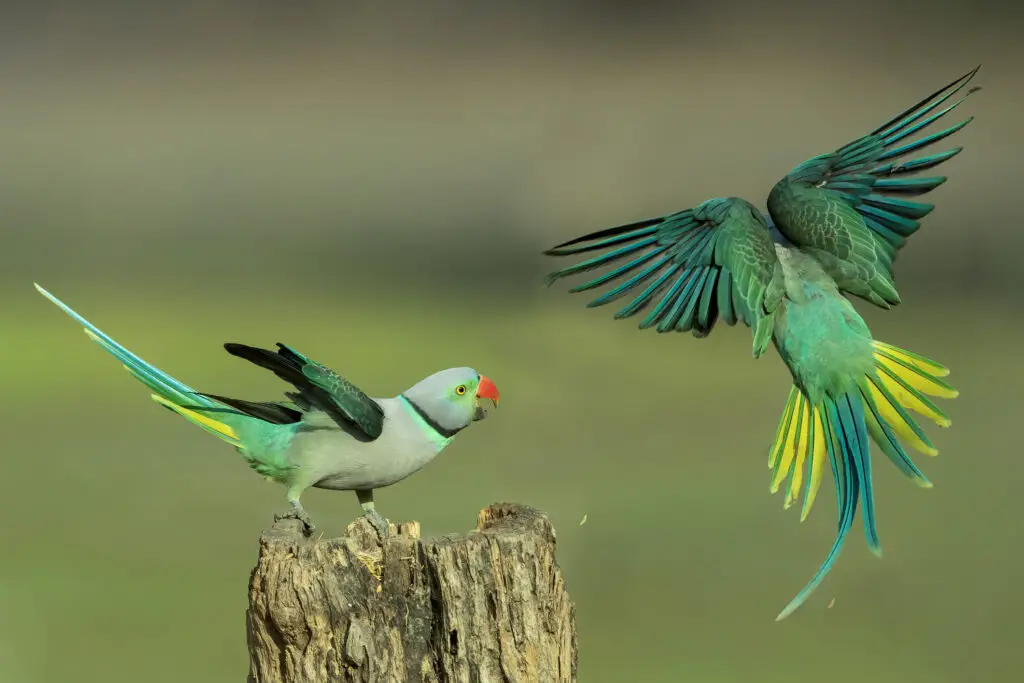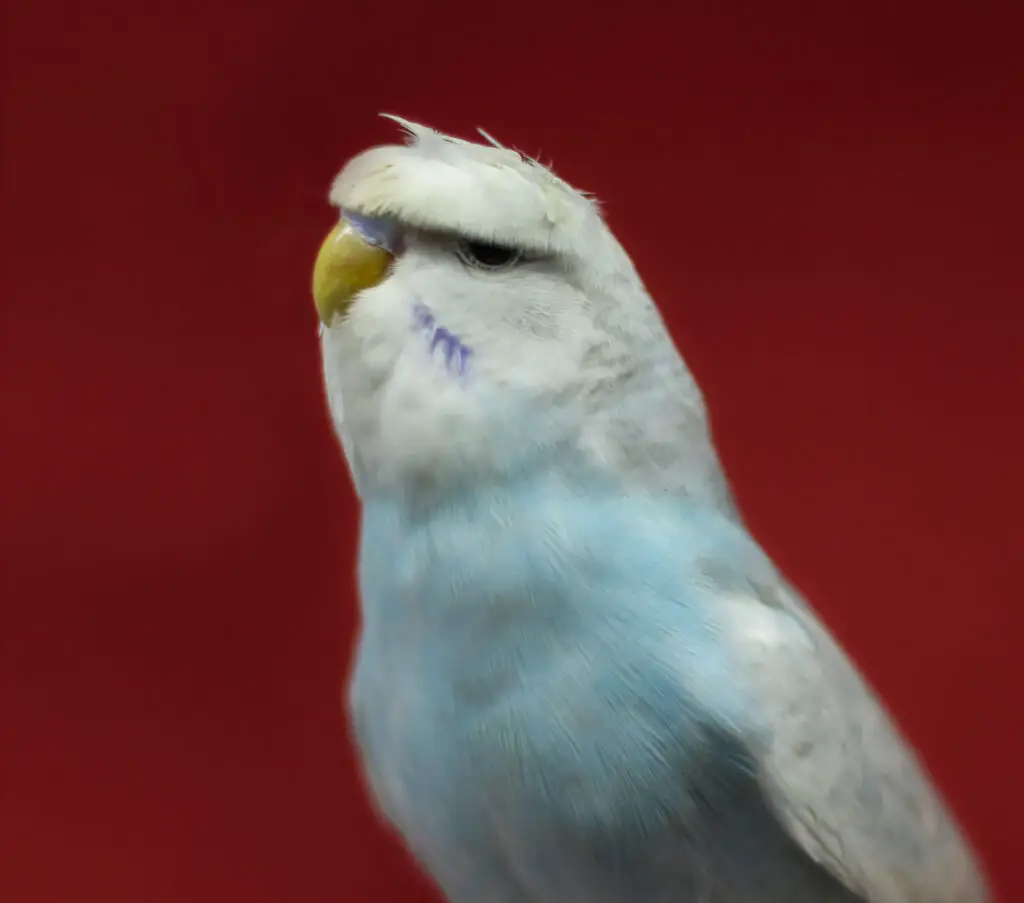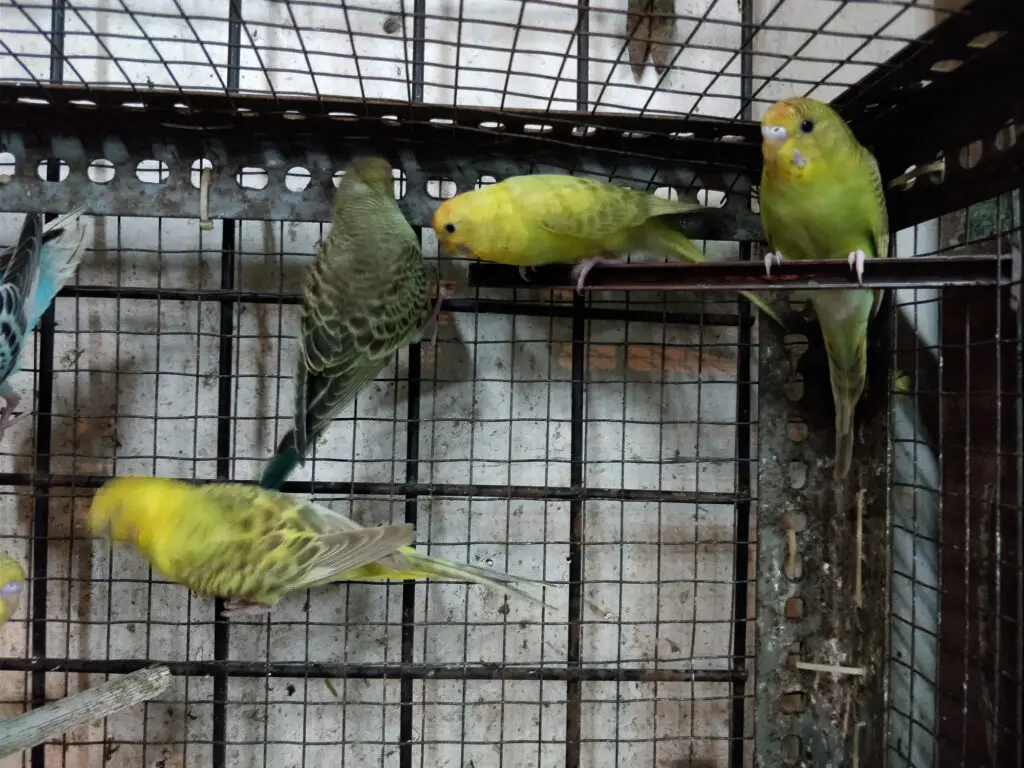If you are looking to take care of a small bird, chances are you are comparing a parakeet vs. a parrotlet. These birds are two of the smallest birds in the parrot family, making them the usual choice of first-time bird owners.
This article will discuss the differences between parakeets and parrotlet to help you choose which bird will fit your demands.
Key Takeaways
Choose a parakeet if:
- You want a vibrant-colored bird with multiple color options
- You want a calm bird that does not have nipping tendencies
- You want a feathered companion that can quickly learn tricks and human language
- You want a singing bird
- You want a pet with a simple diet
Choose a parrotlet if:
- You want a tiny bird that will not take up a lot of space
- You want an affectionate pet that your children can interact with
- You want a quiet bird that learns how to talk
- You want a pet that thrives on nutritional pellets
A Brief Background Comparison Of Parakeet Vs. Parrotlet

Parakeets and parrotlets are small birds of the same species – the psittacines. For this reason, the said birds look similar despite being completely different.
Parakeets are small parrot species famous for their long tails and gorgeous plumage. Make a visual comparison of parakeet vs. parrotlet. You will instantly see that the parakeet is larger than the latter. Parakeets come in different colors; some are solid-colored, while others have multi-colored feathers.
The Pros Of Owning A Parakeet
- Highly social and bonds well with people
- Can learn tricks and mimic human language
- Low maintenance
- Not as noisy as other birds
The Cons
- A parakeet’s health is fragile
- Parakeets are messy eaters, so their cages need frequent cleaning
Meanwhile, parrotlets are small birds that usually have green plumage. Male parrotlets are also primarily green but have blue patches at the back. These birds are famous as the smallest among all species of parrots.
The Pros Of Owning A Parrotlet
- Affectionate and friendly
- Parrotlets do not make much noise
- Ideal for caretakers who want a pet that will bond closely with them
- Fun and entertaining to take care of
The Cons
- Parrotlets can be destructive when bored
- The playfulness of parrotlets makes them prone to trouble and injuries
Parakeet Vs. Parrotlet: The Differences

Parakeets and parrotlets make fantastic family pets due to their affectionate nature. People often choose either of these birds as a pet due to their small size. However, size is not the only factor you must consider when selecting a feathered friend.
You will see some similarities when you compare a parakeet vs. a parrotlet. But they also have differences, which you need to know. When choosing which of these two birds will best fit your home, these differences will be your deciding factor.
Origin
According to the Bulletin de I’Office International d’Hygiene Publique, parakeets come from Australia. In this country, you will find parakeets flying above trees in flocks. These birds’ natural habitat is primarily grasslands, where they do not make nests but live in abandoned nests made by other birds.
Parakeets do not like wet environments. They live better in warm climates and dry areas where they still have access to drinking water. But while they live in dry areas, they are intelligent enough to look for wetlands to avoid dehydration when the weather becomes too hot.
Parakeets wander from one place to another in the wild.
These birds are an easy target for predators due to their small size. For this reason, they live in a flock in the wild to protect themselves from any possible danger. Parakeets travel thousands of miles in a year to forage for food and water in the wild.
According to the American Federation Of Aviculture, parrotlets originated from Mexico, South America, and Central America. There are three genera of parrotlets:
- Touit
- Nannopsittaca
- Forpus
When comparing the behavior of parakeets vs. parrotlets in their natural habitat, it is common for both to live and travel in groups. Parrotlets thrive in lowland forests and shrublands, regardless if their environment is dry or wet. These birds occupy tree hollows as their nests.
The green plumage of parrotlets serves as their camouflage. They hide among grasses and trees as a way of protection against predators.
Parakeets and parrotlets have a similar way of living in their natural habitat.
Appearance
Parakeets and parrotlets are small birds. Adult parakeets usually have a maximum size of 7 inches and a wingspan of 12 inches. These birds are relatively large, weighing only 40 to 60 grams when they reach maturity.
Parakeets, or budgies as some people call them, have striped markings on their wing feathers. Their tails are long and slender. While the usual color of parakeets is green, breeding them produces various other colors. The different standard colors of parakeets are:
- Blue – these parakeets come in three shades – mauve, sky blue, and cobalt. Their color is a recessive mutation, so both parent cockatoos must have the mutated genes they will pass to their offspring. This factor makes blue parakeets challenging to breed.
- Purple – parakeets with purple plumage usually have black and white stripes. Their cheeks have dark purple markings, and the tip of their slender wings is typically black.
- Gray – unlike the common brilliant-colored parakeets, gray parakeets have black tails and blue cheek markings. Some gray parakeets also have black and white stripes on their wings. Their tails tend to be black with white edges.
- Rainbow – as the name suggests, rainbow parakeets have splashes of different colors all over its body.
- Cinnamon – these parakeets have brown wings and pastel-colored bodies. Their tails fade from dark to light.
According to independent researcher Nigel Harcourt-Brown, grass parakeets are the common parakeets kept by bird enthusiasts.
Parrotlets And Their Colors
On the other hand, parrotlets, or pocket parrots, are much smaller than parakeets. Avian care experts say these birds measure around 3.5 to 5 inches. They only weigh 25 grams once they reach maturity.
Unlike parakeets, pocket parrots are stout and have short tails. When comparing the beaks of a parakeet vs. parrotlet, it is evident that both are strong as they can chew wood. However, the latter’s beak is more robust and can bite painfully. For this reason, you should never leave your pocket parrot with a child unsupervised.
Green is the most dominant color of pocket parrots. But unlike parakeets, their standard colors are only green, turquoise, blue, and grey. While the plumage of some parrotlets has other colors, such as white, yellow, fallow, and albino, they come from a genetic mutation, which makes them uncommon.
Parakeet vs. parrotlet, a parakeet is a better choice if you want more color choices for a pet. The colors of parakeets are also more vibrant.
Personality

While parakeets are larger than parrotlets, they are more tolerant of their surroundings. These birds will not show aggression unless you invade their personal space or do something to hurt them.
However, it is worth noting that different parakeets mean different characteristics. So, while these birds are generally calm, some can still be more aggressive than others.
Parakeets will start bonding with their caretakers at a young age, as your parakeets are often unsure of their environment. As they grow old, these birds become more independent, although they will still demand a lot of time with their caretakers.
Like many other birds, parakeets become destructive when bored. For this reason, they need a mentally stimulating environment and toys that will keep them entertained.
If you compare the personality of a parakeet vs. a parrotlet, you will find that the parrotlet is more aggressive. There is a big chance that the parrotlet will bite you, especially if it is unfamiliar with your presence. For this reason, this bird may not be the best choice for people living with children.
Pocket parrots are also territorial.
Suppose you are looking for a feathered companion that is easy to handle. In that case, a parakeet is a better choice than a parrotlet.
Intelligence
If you want a bird that can learn tricks, you may ask yourself, “parakeet vs. parrotlet, which is the smarter bird?” To answer this question, both birds are brilliant.
Parakeets will learn to talk even without their caretakers teaching them how to. They can mimic human language by simply listening to their surroundings. According to Scientific Reports, parakeets, particularly the female ones, are so bright in the wild that they can choose a mate with high cognitive abilities.
Even better, these birds can easily acquire an extensive vocabulary. They can memorize hundreds of words and associate them with their meanings appropriately. Try to communicate frequently with a parakeet using body language. They will learn and understand what those movements mean.
You can also train your parakeet to do tricks. Their intelligence will allow these birds to learn tricks, which can keep you and the bird itself entertained quickly. But to remain smart, you need to keep your parakeet mentally stimulated.
Parrotlet And Its Intelligence
Suppose you compare the talking abilities of a parakeet vs. a parrotlet. In that case, you will discover that a parakeet is a better talker. There is no guarantee that your parrotlet will learn how to talk. But if you are dedicated enough, your feathered companion may acquire an impressive vocabulary and understand meanings.
Moreover, you can teach a pocket parrot to learn tricks. These birds are intelligent, so consistent training will allow them to understand simple commands. When training a pocket parrot, you must ensure that you provide it with treats every time it follows your instructions.
Training a parrotlet should also be in short, consistent sessions. This type of training also applies to a parakeet.
A parakeet makes a fantastic companion if you want a pet bird that is good at talking.
Noises Made
One of the most common things potential pet owners ask before taking a pet bird in is whether or not it is noisy. And since parakeets and parrotlets are a part of the parrot family, you may wonder if they are noisy like other birds.
Parakeets make noises, particularly:
- talking
- chatters
- whistles
However, they do not scream and squawk unless it is threatened, hurt, or not given enough attention.
Although parakeets are small, they can make loud noises. They whistle and sing throughout the day if they are happy. But when these birds are in distress, they may scream or chide to signal their caretakers.
Fortunately, you can prevent parakeets from making loud noises by keeping them busy and comfortable in their enclosure.
But if you compare a parakeet vs. a parrotlet, you will find that the latter is relatively quiet. These birds are perfect for living in apartments or wanting a calm environment.
Still, it is with noting that parrotlets can be noisy sometimes. They will make noises when they need something or call the attention of their caretakers. For this reason, it is vital to check your feathered companion every time it makes unusual noises.
If you live close to your neighbors who might be disturbed by a bird’s noise, the parrotlet is a better choice for a pet.
Diet
Comparing the diets of a parakeet and vs. parrotlet also reveals that both birds like seeds and produce. But while parakeets love seeds, they do not provide adequate nutrition. For this reason, you need to include fruits and vegetables in a parakeet’s diet.
Parakeets love dark leafy greens, broccoli florets, carrots, and sweet potatoes. They will also benefit from eating fruits like blueberries, strawberries, and bananas.
Similarly, a parrotlet’s diet revolves around seeds, fruits, and vegetables. You may even feed a parrotlet with pellets where they can get the nutrition they need.
A parakeet vs. parrotlet generally thrives on the same diet. So, if you are looking for a feathered friend that is not picky regarding food, you may have difficulty choosing between these birds.
Grooming
Parakeet vs. parrotlet, the latter’s beak is stronger. However, the similarity of these birds is that their beaks grow constantly. For this reason, parakeets and parrotlets need regular grooming.
Both birds need a professional groomer to have their nails and beaks trimmed. You may also do the grooming job yourself if you are highly experienced in caring for birds. However, it would be best never to trim these birds’ beaks and nails too short.
Considering how small parakeets and parrotlets are, they can easily bleed to death if you cut their nails and beaks too close to their skin and veins.
More About Parakeet Vs. Parrotlet
- Lifespan – the lifespan of parakeets varies from one species to another. For instance, a study shows that a ring-neck parakeet can live for up to 20 years. Other species may have a shorter lifespan, which ranges from 10 to 15 years.
On the other hand, pet care experts say that parrotlet can live for 15 to 20 years in captivity. Between a parakeet vs. a parrotlet, a parakeet is more susceptible to diseases and needs a lot of healthcare.
- Environment Requirement – parakeets are sustainable pets. However, they prefer a calm environment without too much noise and warm temperatures. According to a study, parakeets may lose their sense of hearing if exposed constantly to noisy environments.
Meanwhile, parrotlets are outgoing and inquisitive. They can interact with children and do well in noisy environments. However, you must ensure that nothing or no one will startle your parrotlet, as they tend to be nippy on such occasions.
Can A Parrotlet And Parakeet Live Together?
When talking about parrotlet vs. parakeet, it is evident that both are good at socialization. Parakeets are social and need constant companionship. They also need to spend time with their caretakers consistently.
On the other hand, parrotlets are playful and also require consistent human interaction. Since both birds are social, can they live together in a single enclosure?
While parakeets and parrotlets need companionship, you should never place these birds together in a single cage. As mentioned, parrotlets are territorial, so they will not tolerate living with other birds unless that bird is their mate. Parrotlets will not think twice about attacking a parakeet, regardless of their size difference.
Even worse, parrotlet constantly bullies a parakeet until you have no choice but to separate them.
If you have a parakeet and a parrotlet at home, the best way to take care of them is to place them in a separate enclosure. This way, the birds will never find a way to hurt each other.
Place these birds’ cages beside each other but not so close that they can reach each other. If your birds are in separate cages but can still reach each other, the parrotlet may still show aggression and try to hurt the parakeet. The former does not stand a chance against the latter’s strong beak in a parakeet vs. parrotlet fight.
When positioned at a safe distance, parakeets and parrotlets will interact by exchanging songs and whistles.
Trying To Cohabitate A Parakeet And Parrotlet In One Cage

Since parakeets and parrotlets have similar behaviors, you may want to try bonding them. A parakeet and pocket parrot living in the same enclosure is rare but not impossible. So, if you think your parakeet and parrotlet are tame enough not to hurt each other, you may train them to cohabitate.
Introduce The Birds
The first step to cohabitating with a parakeet and parrotlet is introducing them to each other. Placing the birds’ cages in the same location will help them familiarize themselves with each other. This way, you can observe whether one bird will show aggression against the other.
Since parakeets and parrotlets are cousins, there is a huge chance they will bond after a proper introduction.
When introducing your two birds, ensure you are not placing the cage near each other. Placing the cages side-by-side will trigger the territorial instincts of these birds. As a result, they will see each other as a threat.
Move The Enclosures Closer
After letting your parakeet and parrotlet familiarize themselves, you can move their enclosures closer together. However, moving the cages closer gradually is best for the birds. This way, your feathered friends can slowly get used to each other as you bring them closer and closer.
Gradually moving the cages will also allow you to observe if your birds will show aggression towards each other as their distance decreases. If you feel like your birds are threatened by each other, it would be best to stop making them live together.
If your birds remain tame, continue with the cohabitating process.
Prepare A Larger Cage
Parakeets and parrotlets may be small but require sufficient space to fly around. So, when training these birds to cohabitate, you must provide them with an enclosure where they will still have their personal space. Failing to give your birds a huge cage will cause them to become destructive and aggressive.
Allow The Birds To Bond
Once your parakeet and parrotlet start to warm up to each other, you can train them to bond closer. For instance, you can interact with your birds outside their enclosure at the same time. Prepare a treat, such as a slice of fruit, and allow your pets to share it every time they bond.
However, you can only do this step if your birds are comfortable with each other’s presence. During training, you must be cautious as your birds may assert dominance, which can injure each other. The process will also take time, so you need a lot of patience when making a parakeet and parrotlet live together.
Furthermore, it would be best never to forget that your birds may not bond. Some birds are territorial, so they may never accept a companion. They may even form a bond at first but become aggressive again after some time.
These Articles May Also Interest You
- The Lovebird Vs. Parrotlet (And Why You Need To Know The Difference)
- Can Parrotlets And Parakeets Get Along? (Find Out Here)
- Reasons Why Parakeets Make Good Pets
- Parakeets And Cockatiels: Are They The Same?
- 5 Reasons Why Parakeets Will Die
- Why Do Parakeets Bob Their Heads?
- When Parakeets Kiss: Why They Do It And What It Means
- Can Parrotlets And Parakeets Get Along? (Find Out Here)
- Can Parakeets Eat Carrots?
- 7 Things A Parakeet Needs
- Parakeets and Cockatiels: A Comparison
- What Does it Mean When Parakeets Puff Up?
- The Parakeet Vs. The Lovebird: The Differences Explained
- French, E. L., R. A. Joske, D. H. Bodycomb, E. F. Mackenzie, and W. R. Rigg. “Psittacosis in Australia.” Medical Journal of Australia 1, no. 11 (1954). https://www.cabdirect.org/cabdirect/abstract/19352701963. Accessed February 12, 2023.
- Molenda, Sandee L., and Robert W. Molenda. “Parrotlets.” AFA Watchbird 26, no. 6. https://watchbird-ojs-tamu.tdl.org/watchbird/index.php/watchbird/article/view/1399. Accessed February 12, 203.
- Harcourt-Brown, Nigel H. “Psittacine birds.” Avian Medicine. Edinburgh: Butterworth-Heimann 1 (2000). DOI:10.1016/B978-0-7020-2874-8.00007-9. Accessed February 12, 2023.
- Pet Supplies Plus. Parrotle. http://www.buffalobirdnerd.com/storage/app/media/PSPParrotlets.pdf. Accessed February 12, 2023.
- Medina-García, Angela, and Timothy F. Wright. “An integrative measure of cognitive performance, but not individual task performance, is linked to male reproductive output in budgerigars.” Scientific Reports 11, no. 1 (2021). https://www.nature.com/articles/s41598-021-91213-3. Accessed February 12, 2023.
- Pithon, JOSEPHINE A., and C. A. L. V. I. N. Dytham. “Census of the British Ring-necked Parakeet Psittacula krameri population by simultaneous counts of roosts.” Bird Study 46, no. 1 (1999). DOI: https://doi.org/10.1080/00063659909461121. Accessed February 12, 2023.
- Dooling, R.J., Popper, A.N. The Effects of Highway Noise on Birds. The California Department of Transportation Division of Environmental Analysis (2007). Accessed February 12, 2023.




